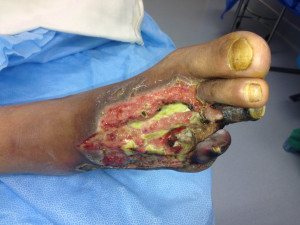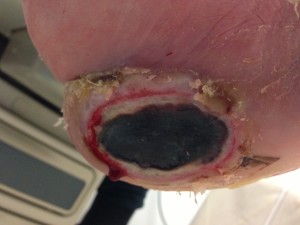Stage I: Non-Blanchable Erythema
- Intact Skin with non-blanchable redness of a localized area usually over a boney prominence. Darkly pigmented skin may not have visible blanching; its color may differ from the surrounding area. The area may be painful, firm, soft, warmer or cooler as compared to the adjacent tissue.
Stage II: Partial Thickness
- Partial thickness loss of dermis presenting as a shallow open ulcer with a red pink wound bed, without slough. Presents as a shiny or dry shallow ulcer without slough or bruising. This stage should not skin tears, tape burns, incontinence associated dermatitis, maceration or excoriation.
Stage III: Full Thickness
- Full thickness tissue loss. Subcutaneous fat may be visible but bone, tendon or muscle are not exposed. Slough may be present but does not obscure the depth of tissue loss. May include undermining and tunneling. The depth of stage III pressure ulcers varies by anatomical location.

Stage IV: Full Thickness Tissue Loss
- Full thickness tissue loss with exposed bone, tendon or muscle. Slough or eschar may be present. Often includes undermining and tunneling. The depth of a stage IV pressure ulcer varies by anantomical location. Stage IV ulcers can extend into muscle and/or supporting structures making osteomyelitis or osteitis likely to occur. Exposed bone/muscle is visible or directly palpable.

Unstageable Full Thickness Skin or Tissue Loss – Depth Unknown (UTD)
- Full thickness tissue loss in which actual depth of the ulcer is completely obscure by slough (yellow, tan, gray, green or brown) and/or eschar (tan, brown or black) in the wound bed. Until enough slough and/or eschar are removed to expose the base of the wound, the true depth cannot be determined; but it will be either a stage III or IV. Stable (dry, adherent, intact without erythema or fluctuance) eschar on the heels serves as “the body’s natural biological cover” and should not be removed.

Suspected Deep Tissue Injury – Depth Unknown (DTI)
- Purple or maroon localized area of discolor intact skin or blood-filled blister due to damage of underlying soft tissue from pressure and/or shear. The area may be preceded by tissue that is painful, firm, boggy, warmer or cooler as compared to adjacent tissue. Deep tissue injury may be difficult to detect in individuals with dark skin tones. This stage can often be confused with acute arterial insufficiency.

Source: The National Pressure Ulcer Advisory Panel (NPUAP)



